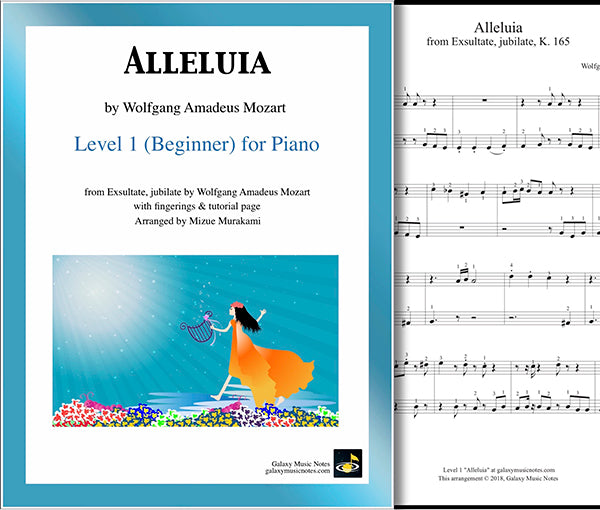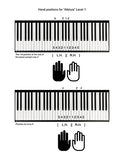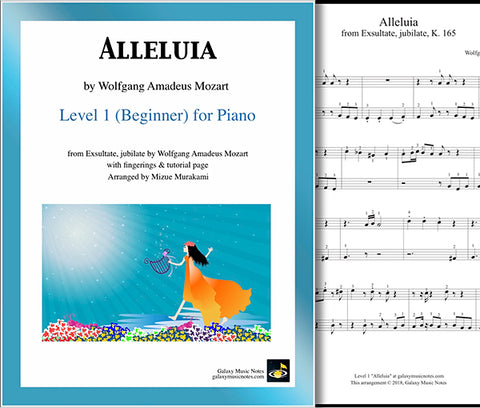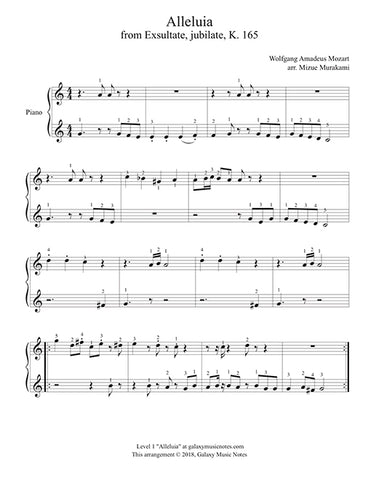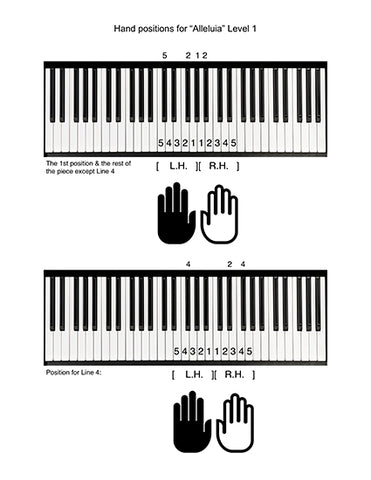Overview of this digital piano sheet music:
- "Alleluia" The 4th Movement: Molto allegro
- From Exsultate, jubilate
- Composer: Wolfgang Amadeus Mozart
- Instrumentation: For piano solo
- Level 1: beginner's level (See other levels of this song)
- Pages:
- 4 pages of music
- Hand-position tutorial page
- Cover sheet
- Key (for this arrangement): C major - G major - C major
- Fingerings: all notes except some repeated notes
- Pedal markings: No pedal necessary for this piece
- Complete audio sample: Always free to listen to on our website. No vocal recording
- Downloading file: PDF
- Arranger and music editor: Mizue Murakami
- Publisher: Galaxy Music Notes
- Product code: GMNS00662
About "Alleluia" by Mozart:
"Alleluia" (4th movement) from Exsultate, jubilate was composed by Austrian composer, Wolfgang Amadeus Mozart. He composed this in 1773. And the picture below of Mozart is a portrait of him in the 1770s. Originally, Exsultate, jubilate is sung by a solo soprano female singer backed by an orchestra. To learn more about "Exsultate, jubilate," please visit our page, "Learn about Exsultate jubilate by Mozart."

Tips for playing "Alleluia" by Mozart - Level 1
This sheet music we provide here on this page is an arrangement for "Alleluia" for piano solo. It is at Level 1 (beginner's level). You will be playing the melody notes only (single note at a time), originally sung by a singer and also some orchestral part when the singer is not singing. There are no additional harmonic notes. The fingering numbers are provided on most notes except some repeated notes so that you can continue to be alert. And the damper (sustain) pedal is not necessary for this piece/arrangement. Although this is at Level 1, it is quite difficult because it's very long (4 pages) and there are some passages where it requires to play fast notes (16th notes). There are 2 hand positions for the entire piece. After you download it, please locate those hand-positions on the tutorial page. You can place your hands as the 1st described position for most of the piece except the 4th line of the 1st page. When you get to the 4th line, please change the position to the 2nd one quickly that is described on the tutorial page as well. And you can go back to the original position after finishing playing the 4 line. If you are a complete beginner, you may not understand the repeat signs. You'll need to repeat (play twice) the 4th line of the 1st page. You also need to repeat the 3rd line of the 2nd page. However, you'll the 1st and 2nd "ending" signs. For the 1st time, go through the measure with a box on the top saying "1." which is called "the 1st ending. Then, the 2nd time, skip that the 1st ending measure and got to the measure with a box on the top saying "2." and keep going to the next line through the end.
Download, Print (or see it on your tablet), and Practice!
This product is a digital download. After you purchase it, you will be downloading a PDF file. You should be able to download it to your desktop, laptop, smartphone or tablet if they are connected to the internet. You'll also receive a download link via email. You may download it later when it's convenient. After you download it, please print it out or see it on your tablet for your use. And most importantly, PRACTICE!
If you have a difficulty downloading a PDF file, you may need to upgrade or download Adobe Acrobat Reader. Please visit Adobe Acrobat Reader to download the newest Adobe Acrobat Reader.
You may also like:
- To learn more about the composer, Wolfgang Amadeus Mozart who composed "Alleluia," please visit our page, "About Wolfgang Amadeus Mozart."
- To find more piano sheet music of compositions by Mozart, please visit our collection page, "By Wolfgang Amadeus Mozart."
- You may also like piano solo arrangements for pieces originally written for opera (vocal pieces). For those, please visit our collection page, "From Opera."

